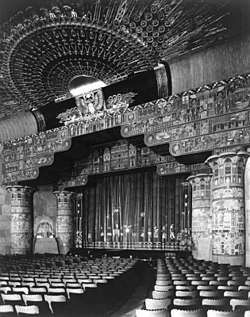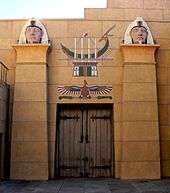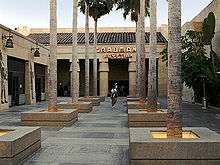Grauman's Egyptian Theatre
| Egyptian Theatre | |
|---|---|
 Grauman's Egyptian Theatre interior, 1922 | |
| Location |
1650–1654 McCadden Pl & 6706–6712 Hollywood Blvd., Hollywood, Los Angeles, California |
| Coordinates | 34°06′03″N 118°20′11″W / 34.10083°N 118.33639°WCoordinates: 34°06′03″N 118°20′11″W / 34.10083°N 118.33639°W |
| Built | 1922 |
| Governing body | private |
| Designated | 1993[1] |
| Reference no. | 584 |
 Location of Egyptian Theatre in the Los Angeles metropolitan area | |
Grauman's Egyptian Theatre is an historic movie theater located at 6706 Hollywood Blvd. in Hollywood, California.[2] Opened in 1922, it's an early example of a lavish movie palace and is noted as having been the site of the first-ever Hollywood film premiere. Since 1998, it has been owned and operated by the American Cinematheque film archive.
History
The Egyptian was built by showman Sid Grauman and real estate developer Charles E. Toberman,[3] who subsequently built the nearby El Capitan Theatre and Chinese Theatre on Hollywood Boulevard.[3] Grauman had previously opened one of the United States' first movie palaces, the Million Dollar Theater, on Broadway in Downtown Los Angeles in 1918. The Egyptian cost $800,000 to build and took 18 months to construct. Architects Meyer & Holler designed the building, and it was built by The Milwaukee Building Company.
The Egyptian was the venue for the first-ever Hollywood premiere, Robin Hood, starring Douglas Fairbanks, on Wednesday, October 18, 1922. As the film reportedly cost over $1 million to produce, the admission price to the premiere was $5. One could reserve a seat up to two weeks in advance for the daily performances. Evening admission was 75¢, $1 or $1.50. The film was not shown in any other Los Angeles theater during that year.
In 1927, Grauman opened a second movie theater further west on Hollywood Boulevard. In keeping with the public fascination in that era with international themes, he named his new theater the Chinese Theatre. Its popularity eventually rivaled and surpassed the Egyptian because of its numerous celebrity handprints, footprints, and signatures in the cement of its forecourt.
Inspiration for other movie theatres

The layout, design, and name of the Egyptian Theatre was emulated by other movie palaces in the USA.[4] Peery's Egyptian Theatre in Ogden, Utah, opened in 1924, is one example.[5]
Architecture
The exterior of the theatre is in the Egyptian Revival style. However, the attentive visitor will notice roof pans above the main entrance, items which are not in ancient Egyptian style. The original plans for the theater show a Hispanic-themed theatre, but at some point these plans were changed to an Egyptian style.
It's probable that this was due to public fascination with the multiple expeditions searching for the tomb of Tutankhamun by archaeologist Howard Carter over the preceding years. (Carter eventually discovered the tomb on November 4, 1922—just two weeks after the Egyptian opened.) At that time, the change in architectural style was determined, the Hispanic-styled roof pans had already been delivered and paid for; they were kept and used in the building.
Following the destruction from the 1994 Northridge earthquake, architecture and design studio Hodgetts + Fung was brought on to design a new cinema and update the technology to accommodate the American Cinematheque’s programming of film and new media in 1997. The exterior was restored to its original appearance a year later while projection, sound, seating, mechanical systems, and circulation were brought up to 21st century standards. In 2000, the project won the National Preservation Award from the National Trust for Historic Preservation.
The exterior and interior walls contain Egyptian-style paintings and hieroglyphs. The four massive columns that mark the theatre's main entrance are 4 1⁄2 feet (1.4 m) wide and rise 20 feet (6 m).
Capitalizing on Southern California's sunny weather is the large courtyard (45 ft × 150 ft (14 m × 46 m)) in the front, complete with a fountain and queen palm trees. This is actually the "entrance hall" (the theatre doors used to open directly into the auditorium) and was specifically designed to host the theatre's famous red carpet ceremonies. Guided tours are offered by American Cinematheque's staff on weekends.
American Cinematheque


As Hollywood declined in the 1980s and early 1990s, the Egyptian closed and fell into disrepair. In 1996, the city of Los Angeles sold the theater to the American Cinematheque for a nominal $1 with the provision that the landmark building be restored to its original grandeur and reopened as a movie theater.
The Cinematheque committed to raising the funds to pay for the restoration and to using the renovated theater as home for its programs of public film exhibition. The Egyptian was reopened to the public on December 4, 1998, after a $12.8 million renovation. The original theater seated 1,760[6] patrons in a single auditorium. In the restored Egyptian, the building has been reconfigured to add a second screening theater. The main theater now accommodates 616 patrons and is named after Los Angeles philanthropist Lloyd E. Rigler. While the interior was rebuilt as two modern cinemas, using some of the decorative elements of the original theater, the exterior was completely restored to its original 1922 appearance.
The American Cinematheque also owns and presents film screenings at the Aero Theatre in Santa Monica.
See also
References
- ↑ Los Angeles Department of City Planning (August 8, 2014). "Historic – Cultural Monuments (HCM) Listing: City Declared Monuments". City of Los Angeles. Retrieved September 16, 2015.
- ↑ King, Susan (March 20, 2014). "Noir City at the Egyptian Theatre has a dark, international lure". The Los Angeles Times.
- 1 2 Lord, Rosemary (2002). Los Angeles: Then and Now. San Diego, CA: Thunder Bay Press. pp. 90–91. ISBN 1-57145-794-1.
- ↑ Landmarktheatres.com
- ↑ "Peery's Egyptian Theater". Peerysegyptiantheater.com. Retrieved 2008-11-16.
- ↑ Seeing-stars.com
External links
| Wikimedia Commons has media related to Grauman's Egyptian Theatre. |